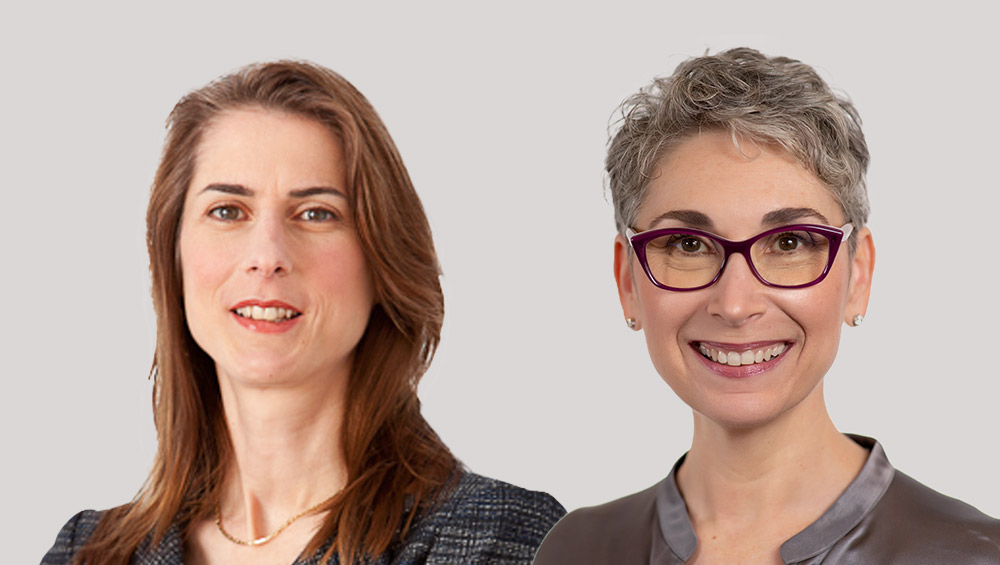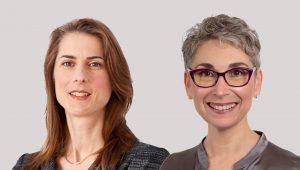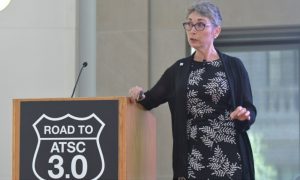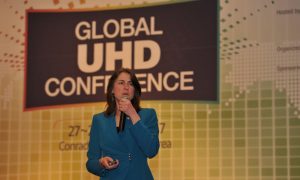
Noland And Auerbach: TVN’s Bright Futurists


Madeleine Noland (left) and Abby Auerbach
For the past eight years, TVNewsCheck has presented its Women in Technology awards to individuals who are established leaders at the forefront of broadcast technology. Also honored are promising up-and-coming members of the engineering community.
This year, TVNewscheck is expanding the awards, choosing two women who will be celebrated for their vision with the new Futurist Awards.
They are Abby Auerbach, executive vice president and chief communications officer of the Television Bureau of Advertising, and Madeleine Noland, senior adviser, technology and standards at LG Electronics, who also chairs the ATSC committee supporting implementation of the new ATSC 3.0 television standard. They are being recognized for pioneering new technologies or who, although not working in the sciences, have significantly influenced the development of media technology.
The inaugural Women in Technology Futurist Awards will be presented at TVNewsCheck’s ninth annual Women in Technology Leadership Awards ceremony and reception during the NAB Show on April 9 at 6 p.m. in the Las Vegas Convention Center. Here’s a look at the two winners:
Abby Auerbach

Abby Auerbach uses a TV ad trope to describe herself: “I’m not a technologist; I just play one at TVB.”
Unlike most of the Women in Technology Award winners, her background is in advertising. She went to Hofstra University with the goal of becoming an advertising creative director and that morphed into an interest in marketing. When she graduated in 1981, she landed a sales assistant position at rep firm HRP in New York.
It was a good fit and a valuable learning experience, she says. “Working with television stations put me in close touch with all of the marketing elements that I had learned about in school and showed me how to use television to target different audience targets and different population segments.
“I was able to use my graphic design capabilities and skills … for the sales reps and there was a time where they considered developing a graphics department that I would lead to help develop sales presentations.”
In 1983 she moved from the rep side to the ad agency world as an assistant buyer in Ogilvy’s broadcast department. She spent 17 years there, rising to director of the entire buying operation for local television and radio in the U.S.
“I was very young at that job and the people there really took a chance on me and supported me. I led a department of about 110 local broadcast buyers. It was a very exciting opportunity to develop businesses, to really learn the strategies and the capabilities and the power of local broadcast from the inside out.”
During her time at Ogilvy, Auerbach was not only chair of the 4A’s local TV and radio committee, but she was also chair of its EDI (electronic data interchange) committee, a post she held for four years.
“I was starting to lead the work to reduce the friction in the buy-and-sell process to speed that process, to reduce discrepancies and to improve the whole … process for buyers and sellers.”
In 2000, TVB hired a new CEO, Chris Rohrs, who had a new vision for the trade association that included working closer with ad agencies, developing advocacy and research and growing the technology of e-business. To help implement the vision, he brought in Auerbach in June of that year as senior vice president of marketing and in September she became executive vice president.
Her agency perspective gave TVB a whole new way of looking at marketing and technology solutions. In 2007, she launched the group’s first e-business effort — ePort, an automated television platform through a consortium of broadcast CTOs, technology developers, sales executives, media buyers and industry associations.
She was immersed in all facets of the platform — hiring the technology providers, bringing in the platform architect, doing all of the marketing and building the advocacy programs. “Really, it was building a business on behalf of the industry with the broadcasters’ support,” she says.
More than 2,400 TV stations and 700 media agencies have used ePort over the past 11 years to handle $30 million of local TV business, she says.
Mike McHugh SVP of media sales and electronic delivery at Strata (the company that operates ePort today) called ePort “the first line of automation between buyers and sellers.”
Auerbach realizes the technology has to keep up with the changes in the media world. “Television stations now have digital subchannels and they have websites and they have OTT channels. So there are so many more things that can be bought and sold. So more sophisticated technology, more sophisticated standards are required.”
Enter the TIP Initiative, a consortium of broadcast groups that came together in 2017 to further streamline advertising transactions for local TV broadcasters and their media agency partners.
Among the broadcasters in TIP are NBCUniversal Owned Television Stations, Hearst Television, Nexstar Media Group, Gray Television, Sinclair Broadcast Group, Tegna and Tribune Media.
This year, TIP is focusing on adding more system providers, media agencies and broadcasters and expanding the variety of interfaces to include inventory avails, proposals, makegoods and commercial instructions.
Auerbach’s work with TIP, she says, “is in promoting the importance of optimizing interoperability between buying and selling systems, reducing the friction, increasing the accuracy, the transparency and giving more functionality into the advancement of how we buy, sell and use our medium.
“Down the road, we definitely see a future where all of this automation interoperability enables lots and lots of partners to participate. It also facilitates the move from a ratings-based model of buying and selling to an impressions-based model.”
The end game with TIP, Auerbach says, is for the technology to enable the future of the industry. “We never want the technology to drive how we do business. We want the technology to facilitate the vision of the business.”
TVB CEO Steve Lanzano is enthusiastic about Auerbach’s achievements. “Marshalling industry support and adoption of new technology is no easy task. Abby has exemplified superb leadership through her outstanding consensus building and business building skills. She has expertly leveraged opportunity and coalesced disparate industry groups to drive essential eBusiness solutions for the local broadcast TV marketplace.”
Auerbach’s experience with technology differs from many other people’s, she says. “I became a woman in technology by virtue of being a technology user and being able to have a vision for how technology will advance the industry, and embracing that and leading the charge and by marshalling the technologists who for the most part were all men.
“I am very excited about the future of our industry. I think it’s all about how technology is going to drive the vision that our buyers and our sellers and our advertisers have.”
Madeleine Noland

When Madeleine Noland graduated from the University of Massachusetts in 1989 she had a bachelor’s degree in music. So how did she make her way into the rarified world of television technology she now inhabits at LG Electronics and as the chair of the ATSC committee supporting implementation of the next-gen TV standard ATSC 3.0?
“I was lucky,” she says. “My father was a [microbiology] professor at the University of Massachusetts and he was happy to expose me and my siblings to a variety of technology. When I was growing up in the 1970s, mainframe computers were coming online and he taught us how to access the mainframe [at the university] and how to program in Fortran and Basic.
“I applied to U Mass. to be a math education major and I scored a perfect score on the math placement exam. They put me in some pretty hard classes and right before the semester started, I said: ‘You know, maybe I’m going to do music instead.’
“So I changed my major to a music education, but I still did a whole bunch of math classes because it’s a passion of mine. I also learned Pascal [a computer programming language], finished in 1989 cum laude and then about three years later I completed my math teaching certificate at Middle Tennessee State University.”
She quickly realized, however, that music wasn’t her thing. But it was 14 years working in the restaurant and cartography businesses before she made her way into television in 2004.
“I started working with a startup called Backchannelmedia. They were working with direct response advertising using the 1-800 number system and the wanted to use digital TV to bring interactivity to the broadcast platform and … make this direct response advertising a real measurement tool for all advertisers.”
The company’s concept, she says, “was to not only make this interactivity possible, but to use the cable TV interactive engines … to provide the inputs at the broadcast station to create a system which included a streaming server and a back-end system for creating interactive moments for broadcasters … and then also work with the cable operators to pass those ‘clickable’ moments to a set-top box … and then the interactivity is drawn on the screen for the viewer.”
Noland eventually became the company’s CTO and coauthored three patents. Around 2011, she began attending ATSC meetings, feeling that if Backchannelmedia was going to be involved in television’s future, she needed to learn what was in store.
She became involved in an early ATSC 3.0 planning committee and then became vice chair of one of the specialist groups when Backchannelmedia sold its patents and closed its doors. She then spent a short time at channel automation firm TelVue as a product manager, all the while still working with ATSC.
Noland joined LG Electronics in April 2013, initially working on its ATSC 3.0 team in LG’s office of the chief technology officer and then consulting for its standards technology and development team at the Convergence R&D Lab before moving to a senior technology and standards role at its Zenith R&D Lab.
At ATSC, she was tapped to chair its Specialists Group on Applications and Presentation for ATSC 3.0, which focused on user experience, including support for next-generation video and audio codecs, linear TV services, interactive applications, accessibility including closed captioning and other features.
She led the effort to develop key ATSC 3.0 features, including vetting of standards for watermarking, advanced emergency alerting, personalization and companion devices. The same group also enabled compelling high-quality video capabilities, as well as high dynamic range and wide color gamut solutions.
With her work on the Specialists Group, Noland helped to frame the system requirements for ATSC 3.0, coordinating the full documentation of the new standard with the work of other committees. She also played an active role in developing user scenarios that describe the desired attributes of the new standard.
Her work with ATSC was recognized in February 2018 when she was chosen to succeed Triveni Digital’s Richard Chernock as chairman of the ATSC Technology Group.
ATSC President Mark Richer said at the time: “Throughout the development of the ATSC 3.0 suite of standards, Madeleine has been a consistent and dependable leader. She is adept at forging agreements on difficult technical issues within the collaborative standards development process. Following in Rich’s footsteps is a logical progression for her.”
In addition to her work with ATSC, Noland is active with the guidelines work group of the Ultra HD Forum, a consortium of broadcasters, service providers, consumer electronics and technology vendors that are collaborating on solving the real-world hurdles, and accelerating ultra HD deployment.
The guidelines work group, she says, “publish guidelines intended to help service providers understand the landscape and the variety of parameters such as, are you going to do HDR or SDR; are you going to do light color gamut or not; are you going to do high frame rate or not; and how all these fit together and how you can build a linear service with all these various things.
“We kind of see ourselves as the plumbers of the UHD industry, of how do you get this stuff from point A to point B. We have done five iterations of the guidelines so far and we have a sixth, new version coming out very soon. That has been a very interesting part of my work. LG has been incredibly supportive for that.”
LG is a founding member of the Ultra HD Forum.
Back at ATSC, Noland explains that in addition to creating standards, “we are also working on recommended practices.”
There are thousands of different combinations with the physical layer that are possible within the standard, she says. “What you need is a recommended practice to say: of all these myriad things that you can choose from within the ATSC system, here are some things that we recommend you do depending on what you want to do. If you want to have a mobile signal or if you want to have a fixed signal, here is the way we recommend you get started.”
She’s optimistic on the progress 3.0 is making in the industry. “I think that the most important thing for next-gen TV is for there to be a critical mass development. You are always going to have early adopters and first followers and people that come late to the party.
“What I see happening is the critical mass is absolutely forming and, in my opinion, the critical mass is starting to form with the Phoenix market model partners which includes the Pearl stations as well as NBC, Fox, Univision and others. Put that together with Sinclair and their Spectrum Co. consortium and, in my opinion, you do have that nut of critical mass already, and if those groups are successful in the plans that they’re talking about, then I believe that the snowball [of adoption] will take care of itself from there.
“The most important next step is really strong coordination between the broadcasters and the consumer electronics makers and the equipment vendors. We have opportunities within the Phoenix model market and within Dallas and other areas where we can sit down together and we can talk about how we are going to do this as an industry. I think 2019 and 2020 are going to be very important years.”
ATSC Board Chairman Lynn Claudy, NAB senior vice president of technology, is one of Noland’s many fans in the industry. “I’m so impressed with how Madeleine can command a room full of opinionated engineers. Seriously, she has earned their respect.
“She’s scary smart and she’s skillful at getting the best out of individuals in a group. Madeleine represents the ATSC and her company exceedingly well. In addition to her passion and knowledge, she brings the right combination of consensus builder and tough negotiator to her role as chair of the ATSC’s Technology Group.”
And her contributions are also celebrated at her “real” job. LG Electronics Senior Vice President Dr. Jong Kim, president of the Zenith R&D Lab, says, “Madeleine is a key contributor, both to LG and the industry. Her leadership of the ATSC 3.0 technology group, which as we all know is sort of an old boys’ society, is especially noteworthy.
“As ATSC 3.0 moves from the laboratory into the marketplace, I expect Madeleine’s standards stewardship and evangelism to play an important role in Next Gen TV implementations by broadcasters and manufacturers alike.”
And despite all of Noland’s activity championing the future of television technology, she still has time for her earlier music passion. She is a wind synth and keyboard player in a Massachusetts progressive rock band called Eccentric Orbit, continuing, as she has throughout her television career, to follow a different drummer.
































Comments (0)